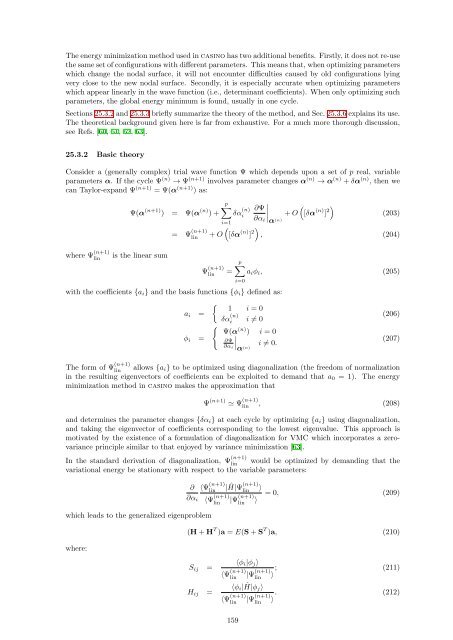CASINO manual - Theory of Condensed Matter
CASINO manual - Theory of Condensed Matter
CASINO manual - Theory of Condensed Matter
Create successful ePaper yourself
Turn your PDF publications into a flip-book with our unique Google optimized e-Paper software.
The energy minimization method used in casino has two additional benefits. Firstly, it does not re-use<br />
the same set <strong>of</strong> configurations with different parameters. This means that, when optimizing parameters<br />
which change the nodal surface, it will not encounter difficulties caused by old configurations lying<br />
very close to the new nodal surface. Secondly, it is especially accurate when optimizing parameters<br />
which appear linearly in the wave function (i.e., determinant coefficients). When only optimizing such<br />
parameters, the global energy minimum is found, usually in one cycle.<br />
Sections 25.3.2 and 25.3.3 briefly summarize the theory <strong>of</strong> the method, and Sec. 25.3.6 explains its use.<br />
The theoretical background given here is far from exhaustive. For a much more thorough discussion,<br />
see Refs. [60, 61, 62, 63].<br />
25.3.2 Basic theory<br />
Consider a (generally complex) trial wave function Ψ which depends upon a set <strong>of</strong> p real, variable<br />
parameters α. If the cycle Ψ (n) → Ψ (n+1) involves parameter changes α (n) → α (n) + δα (n) , then we<br />
can Taylor-expand Ψ (n+1) = Ψ(α (n+1) ) as:<br />
where Ψ (n+1)<br />
lin<br />
Ψ(α (n+1) ) = Ψ(α (n) ) +<br />
is the linear sum<br />
= Ψ (n+1)<br />
lin<br />
+ O<br />
p∑<br />
i=1<br />
Ψ (n+1)<br />
lin<br />
=<br />
δα (n)<br />
i<br />
with the coefficients {a i } and the basis functions {φ i } defined as:<br />
∣<br />
∂Ψ ∣∣∣α (<br />
+ O [δα (n) ] 2) (203)<br />
∂α i (n)<br />
(<br />
[δα (n) ] 2) , (204)<br />
p∑<br />
a i φ i , (205)<br />
i=0<br />
a i =<br />
φ i =<br />
{ 1 i = 0<br />
δα (n)<br />
i i ≠ 0<br />
{ Ψ(α (n) ) i = 0<br />
∂Ψ<br />
∂α i<br />
∣ ∣∣α<br />
(n)<br />
i ≠ 0.<br />
(206)<br />
(207)<br />
The form <strong>of</strong> Ψ (n+1)<br />
lin<br />
allows {a i } to be optimized using diagonalization (the freedom <strong>of</strong> normalization<br />
in the resulting eigenvectors <strong>of</strong> coefficients can be exploited to demand that a 0 = 1). The energy<br />
minimization method in casino makes the approximation that<br />
Ψ (n+1) ≃ Ψ (n+1)<br />
lin<br />
, (208)<br />
and determines the parameter changes {δα i } at each cycle by optimizing {a i } using diagonalization,<br />
and taking the eigenvector <strong>of</strong> coefficients corresponding to the lowest eigenvalue. This approach is<br />
motivated by the existence <strong>of</strong> a formulation <strong>of</strong> diagonalization for VMC which incorporates a zerovariance<br />
principle similar to that enjoyed by variance minimization [63].<br />
In the standard derivation <strong>of</strong> diagonalization, Ψ (n+1)<br />
lin<br />
would be optimized by demanding that the<br />
variational energy be stationary with respect to the variable parameters:<br />
∂ 〈Ψ (n+1)<br />
lin<br />
∂α i<br />
which leads to the generalized eigenproblem<br />
|Ĥ|Ψ(n+1) lin<br />
〉<br />
〈Ψ (n+1)<br />
lin<br />
|Ψ (n+1)<br />
lin<br />
〉<br />
= 0, (209)<br />
(H + H T )a = E(S + S T )a, (210)<br />
where:<br />
S ij =<br />
H ij =<br />
〈φ i |φ j 〉<br />
〈Ψ (n+1)<br />
lin<br />
|Ψ (n+1)<br />
lin<br />
〉 ; (211)<br />
〈φ i |Ĥ|φ j〉<br />
〈Ψ (n+1)<br />
lin<br />
|Ψ (n+1)<br />
lin<br />
〉 . (212)<br />
159

















